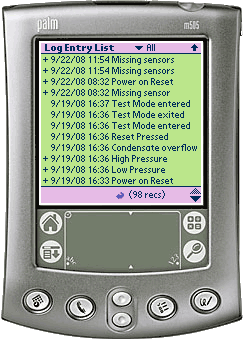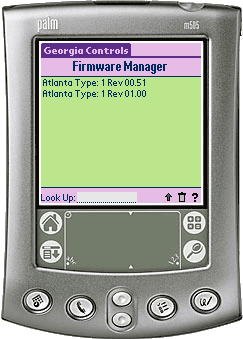Atlanta Series Geothermal HVAC Control
Board
PDA Interface
P/N
236-802
The Atlanta series control board is set up in the factory and in the field with a Palm compatible Personal Digital Assistant. Like the Atlanta series control board software, the PDA software is all written by Georgia Controls employees in the facility, and not "farmed out." For the OEM and the installer, this means that the PDA software is fully compatible, and 100% aware of every intricacy of the Georgia Controls products, making the PDA software simply an extension of the controller in the heat pump.
FREE Software
 Georgia Controls provides its PDA
software FREE to OEMs and installers:
Georgia Controls provides its PDA
software FREE to OEMs and installers:
- FREE - ATL Setup - This application allows the user to easily and quickly set up nearly all of the programmable, settable, and adjustable parameters in Atlanta series control boards.
- FREE - GC Firmware - With this program a technician can update the entire base program in an Atlanta series control board in the field!
- FREE - ATL Toolbox - Allows a technician to do field diagnostics, retrieve statistics, test specific systems and much more.
- FREE - ATL Logs - Atlanta series control boards store log files with events in them for technicians to evaluate during service calls. ATL Logs allows the technician to retrieve and review the logs on site, and store them for review later.
Upgrades to these programs are also FREE, and can be downloaded off of the Support page.
To be notified whenever upgrades to Georgia Controls programs are available, sign up on the Subscribe page. (return to summary page)
 Settings Programmed From PDA - "ATL Setup"
Settings Programmed From PDA - "ATL Setup"
ATL Setup allows all changeable settings to be setup through an easy to use interface. Some settings are available for untrained users, and some are password protected and only allowed for factory use. The vast majority are available for factory or technician use in the field. Here is a sample of what kind of Atlanta series control board settings are adjusted using the ATL Settings program:
- Notes can be set by the PDA and stored in the control board
- System satisfaction priority
- Programmable stage capacity per zone using ZoneSum TM technology
- Thermostat type in each zone (heat pump or conventional thermostats)
- Programmable cooling CFM per stage with variable speed fans
- Adjustable dehumidification target in cooling with variable speed fan
- Programmable heating CFM per stage with variable speed fans
- Enable or disable heat strip assist (extra heat stage)
- Choose to desuperheat in heating, cooling, neither or both
- Programmable humidification target in heating when used with humidifier driven by auxiliary relay
- Programmable fan speed per zone for blower only (G) calls with variable speed fan
- Intelligent or timed upstaging system - Intelligent system allows choosing upstage thresholds by change in temperature over time with separate setups for heating and cooling
- All compressor, temperature, pump cycling, and time settings for all the forms of hot water supported: Priority Demand, AutoDHW TM, and Desuperheating for both domestic hot water and auxiliary hot water (dual hot water systems)
- Embedded FreezeCop TM settings (factory adjustable only)
- Settings for number of compressors and stages,
- Number of compressors
- Number of stages
- Variable speed fans
- Cumulative multispeed fans
- Exclusive multispeed fans
- Settings for up to 4 auxiliary relays
- Geothermal loop pre-flow
- Programmable damper close delays
- And other factory adjustable settings such as:
- Compressor restart delay
- Medium over pressure upstage delay
- Medium over pressure loop run on delay
- Pressure fault tolerance
- Pressure fault lockout delays
- Pressure fault window (return to summary page)
|
 Toolbox for field diagnostics - "ATL
Toolbox"
Toolbox for field diagnostics - "ATL
Toolbox"
ATL Toolbox allows a technician in the field to do all of the following to an Atlanta series control board:
- Get system information, which is basic information about this control board
- Download run statistics including:
- Compressor run times
- Compressor cycles
- Loop pump run time
- Fan run time
- Heat strip run time
- Percentage of time running in each stage
- Find out all the reasons the service required light is illuminated on the control board
- Check the temperatures of all the Georgia Controls compatible sensors embedded in the heat pump
- Test specific systems of the heat pump such as:
- Toggle the freon flow reversing valve
- Run compressors in a specific stage, regardless of thermostat inputs
- Run the fan at any speed without the compressors running
- Open or close any damper
- Turn on or off the loop pump
- Turn on or off the domestic hot water pump
- Turn on or off the heat strips
- Open or close all 4 auxiliary relays
- Set the system to ignore low pressure inputs for freon charging
- Defeatable timer for how long to stay in the selected mode before switching back to normal run mode
- Search for new sensors on the Georgia Controls bus (return to summary page)
 Event logs -
"ATL Logs"
Event logs -
"ATL Logs"
ATL Logs allows a technician in the field to download event logs from an Atlanta series control board. This powerful feature gives the technician magician-like powers when determining what problems a heat pump has been experiencing. The technician can also store the log entries for later comparison or for off-site review.
The event log summary pages can be viewed from newest to oldest or from oldest to newest. This versatility can help the technician find when a problem started and help him determine a course of action more quickly.
Another useful tool found in ATL Logs is the ability to only view the type of log entries that pertain to the problem being diagnosed. The technician may choose severity level masks which allow ATL Logs to display:
- All log entries
- Severe log entries only
- Important log entries only
- Log entries which show when and what updates were performed
- Minor entries which still may effect the heat pump
Many log entries shown on the event log have a "+" symbol next to the entry. This tells the technician there are more details available about this log entry. Clicking on entries that have a "+" next to them pops up with detailed information such as:
Details |
In this example, the technician can see that all sensors located in this unit's lower left sensor leg are missing. This quickly tells the technician that there is a loose connection between the main sensor harness and the lower left sensor leg. |
Details |
This example tells the technician when someone has recently serviced the heat pump and updated the firmware. |
Details |
There is a great deal of information to be learned from log
details like this. When the high pressure safety switch cut off the compressor
on this summer day, the house was at a reasonable temperature, but the
compressor and loop have extreme temperature differentials. The compressor
suction and air supply temperatures tell us the coil was not frozen. From the
720CFM note, we can tell we were running in a 2 ton stage. We can also draw
several conclusions from the loop and AHW pump being on (aux relay). First,
with a high compressor temperature like this and the DHW pump not being on
(because it is not listed), we can see that a great deal of heat has been
shunted into the DHW tank already, and it being cut off tells us that this
water tank must be at maximum temperature. We can see we have a dual hot water
system and that we were desuperheating into the auxiliary (secondary) hot water
system trying to get rid of heat where we can. Also, the loop is running which
tells us that we have too much heat for AutoDHW
TM. |
All of the details and event information are stored in the PDA automatically when the logs are downloaded from the Atlanta series control board. The logs can be viewed at the site, but since they are stored, they may also be viewed off-site later for review. When the technician is done with a set of logs they are easily deleted. (return to summary page)


 Field Upgradable Firmware - "GC
Firmware"
Field Upgradable Firmware - "GC
Firmware"